What to Know
If you’re a dog owner, you know the importance of grooming your pet. Regular grooming helps keep your dog’s coat clean and healthy, and it can also help prevent skin problems. However, sometimes dogs can experience skin problems after grooming, which can be frustrating for both you and your pet. In this article, we’ll explore some of the potential causes of skin problems after grooming, common symptoms to look out for, and what you can do to prevent and treat these issues.
Understanding dog skin problems is essential to keeping your pet healthy and happy. Skin problems can range from minor irritations to more severe conditions that require medical attention. When it comes to skin problems after grooming, there are several potential causes. Dogs can experience clipper burn or razor rashes if the groomer uses clippers that are too hot or if the dog has severe matting that requires a close shave. Other potential causes include allergic reactions to grooming products or bacterial or fungal infections.
If you notice that your dog is experiencing skin problems after grooming, it’s essential to take action quickly. Ignoring the issue can lead to more severe problems down the line. Keep reading to learn more about the common symptoms of dog skin problems and what you can do to prevent and treat these issues.
Key Takeaways
- Skin problems after grooming can be caused by clipper burns, allergic reactions, or bacterial or fungal infections.
- Common symptoms of dog skin problems include itching, redness, and discomfort.
- To prevent and treat skin problems after grooming, use high-quality grooming products, keep your dog’s coat clean and well-maintained, and seek veterinary care if necessary.
Understanding Dog Skin Problems After Grooming
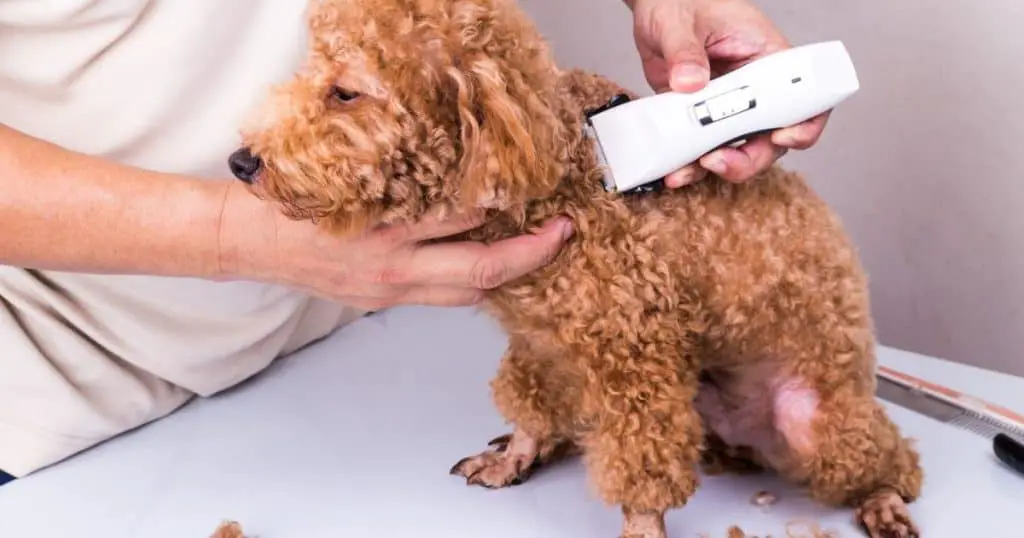
As a dog owner, you want to ensure that your furry friend is healthy and happy. However, sometimes skin problems can arise after grooming, leaving your dog feeling uncomfortable and in pain. Understanding the reasons behind these skin problems can help you identify them early and take the necessary steps to prevent them from happening in the future.
After grooming, especially when using electric clippers or scissors to trim hair, a dog’s skin can become irritated. This is especially true around sensitive areas like the face, genitals, and anus. Dull or overheated blades on electric clippers can snag hairs and irritate the skin, or cause outright burns. Additionally, clipping hair too short can lead to clipper burn, which can cause redness, itching, and discomfort for your dog.
Another common cause of skin problems after grooming is folliculitis, which is the inflammation of hair follicles. This can be caused by a clipper wound, where the hair is clipped too short and the skin is cut, or by bacteria entering the hair follicle. Folliculitis can cause redness, bumps, and pustules on your dog’s skin.
Matting is another issue that can cause skin problems after grooming. When a dog’s coat becomes matted, it can trap dirt, debris, and moisture against the skin, leading to skin irritation and infection. When mats are removed, it can expose the skin to irritants and bacteria, causing further problems.
It’s important to note that some dogs are more prone to skin problems than others. Breeds with long hair or thick coats, such as Poodles, Shih Tzus, and Golden Retrievers, are more susceptible to matting and skin irritation. Additionally, dogs with allergies or other underlying health conditions may be more prone to skin problems after grooming.
By understanding the common causes of skin problems after grooming, you can take steps to prevent them from happening to your furry friend. Regular grooming sessions, including brushing and bathing, can help prevent matting and keep your dog’s coat healthy. Additionally, using high-quality grooming tools and keeping blades sharp can help prevent clipper burn and other skin irritations. If you notice any signs of skin problems after grooming, such as redness, itching, or bumps, it’s important to consult with your veterinarian to determine the best course of treatment for your dog.
Potential Causes of Skin Problems After Grooming
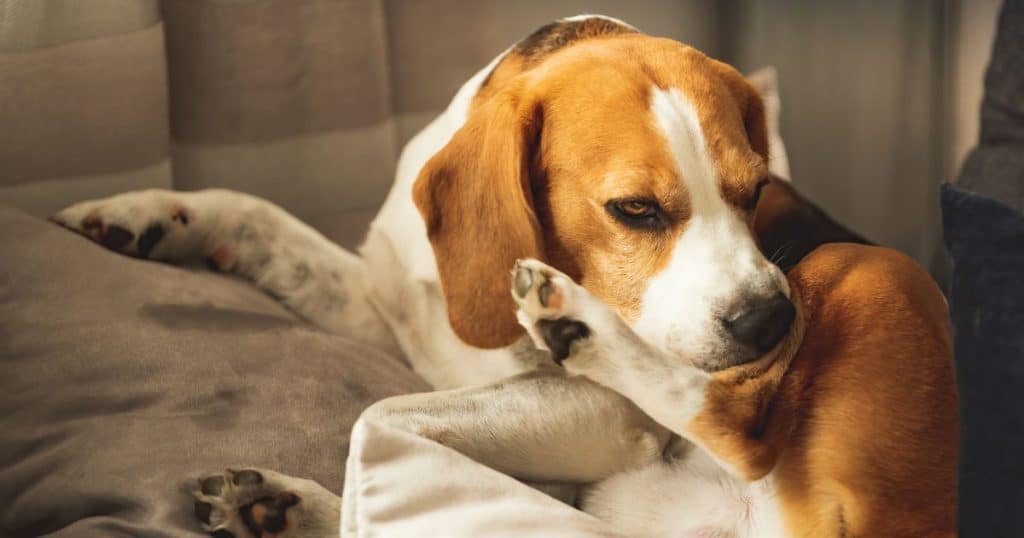
If your dog is experiencing skin problems after grooming, there could be several potential causes. In this section, we will discuss some of the most common causes of skin problems after grooming, including improper grooming techniques, allergic reactions, and parasitic infections.
Improper Grooming Techniques
One of the most common causes of skin problems after grooming is improper grooming techniques. This can include using dull or overheated blades on electric clippers, which can snag hairs and irritate the skin, or cause outright burns. It can also include repetitive brushing in the same area, which can cause razor burn and irritate sensitive skin. Additionally, if your groomer is not using proper hygiene practices, it can lead to the spread of infections and skin problems.
Allergic Reactions
Another common cause of skin problems after grooming is allergic reactions. Dogs can be allergic to a wide range of things, including grooming products, shampoos, and even certain types of foods. If your dog is experiencing skin problems after grooming, it could be due to an allergic reaction to one of these things. Some of the most common symptoms of an allergic reaction include itching, redness of the skin, and discomfort.
Parasitic Infections
Finally, parasitic infections can also cause skin problems after grooming. Parasites like fleas and ticks can cause a range of skin problems, including itching, redness, and discomfort. If your dog is experiencing skin problems after grooming, it could be due to a parasitic infection. It is important to treat any parasitic infections promptly to prevent them from spreading and causing further damage to your dog’s skin.
In conclusion, if your dog is experiencing skin problems after grooming, it could be due to improper grooming techniques, allergic reactions, or parasitic infections. It is important to identify the cause of the problem and take steps to address it promptly to prevent further damage to your dog’s skin.
Common Symptoms of Dog Skin Problems
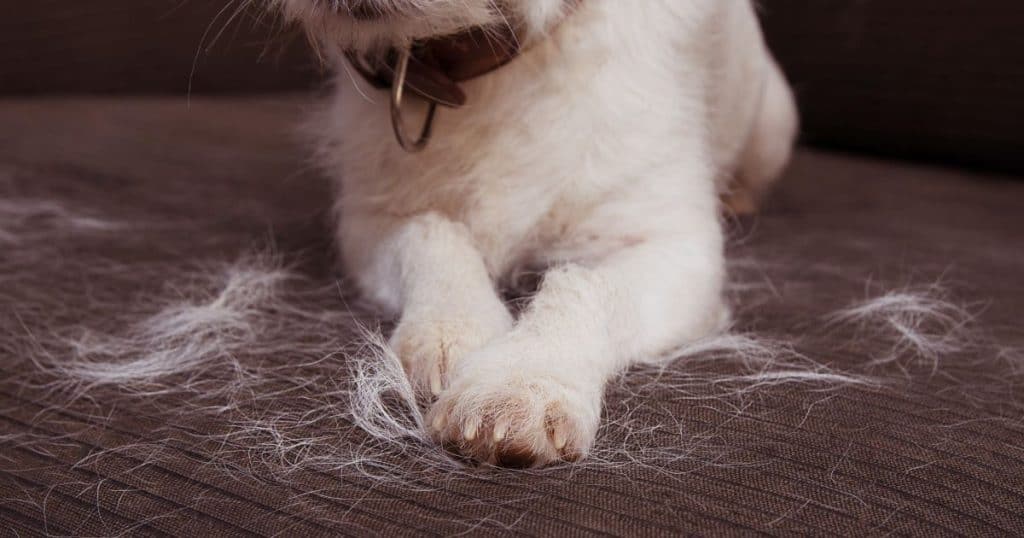
If you notice that your dog is exhibiting any of the following symptoms after grooming, it may be a sign of skin problems:
Excessive Scratching
Dogs that have skin problems tend to scratch themselves a lot more than usual. This can be due to a variety of reasons, including allergies, infections, or irritations caused by grooming. If you notice your dog scratching themselves excessively, it’s important to take them to a veterinarian as soon as possible.
Redness and Inflammation
Redness and inflammation are also common signs of skin problems in dogs. This can be caused by a variety of factors, including allergies, infections, or irritations caused by grooming. If you notice your dog’s skin is red or inflamed, it’s important to take them to a veterinarian as soon as possible.
Hair Loss
Hair loss is another common symptom of skin problems in dogs. This can be caused by a variety of factors, including allergies, infections, or irritations caused by grooming. If you notice your dog losing hair, it’s important to take them to a veterinarian as soon as possible.
In conclusion, if you notice your dog exhibiting any of the above symptoms after grooming, it’s important to take them to a veterinarian as soon as possible. Skin problems in dogs can be caused by a variety of factors, and it’s important to identify and treat the underlying cause in order to prevent further complications.
Prevention of Skin Problems After Grooming
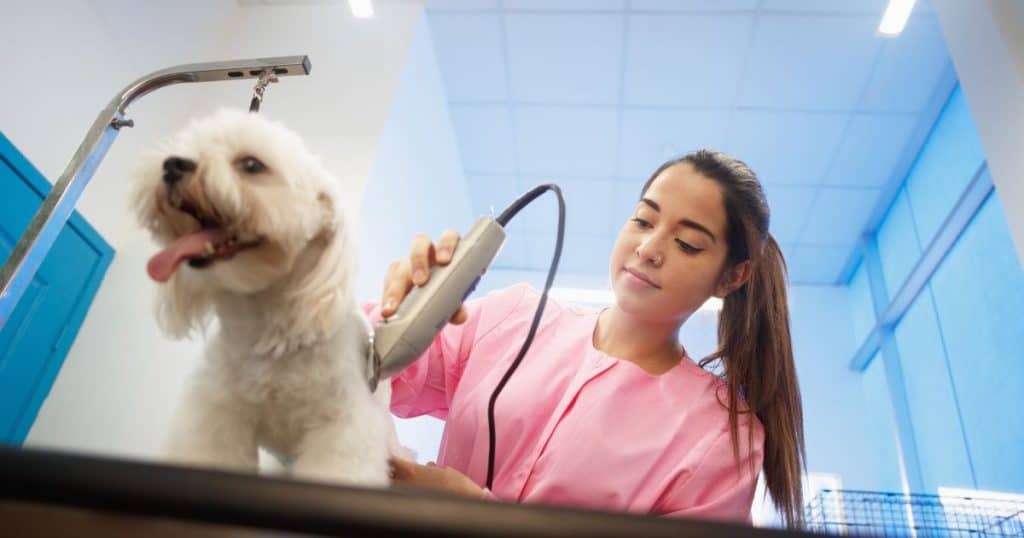
If you have a pet dog, you know how important grooming is to keep them healthy and happy. However, grooming can sometimes lead to skin problems in dogs. To prevent skin problems after grooming your dog, you need to follow proper grooming practices and regularly take your dog to the vet for check-ups.
Proper Grooming Practices
To prevent skin problems after grooming your dog, it is important to follow proper grooming practices. Here are some tips to keep in mind:
- Use the right grooming tools: Use the right grooming tools for your dog’s coat type. Using the wrong tools can lead to skin irritation and other problems.
- Use the right shampoo: Use a shampoo that is specifically designed for dogs. Human shampoos can be too harsh for a dog’s skin and lead to dryness and irritation.
- Rinse thoroughly: Make sure to rinse your dog thoroughly after shampooing to remove all the shampoo residue. Shampoo residue can lead to skin irritation and other problems.
- Dry your dog properly: Make sure to dry your dog properly after bathing. Wet fur can lead to skin irritation and other problems.
- Avoid over-grooming: Over-grooming can lead to skin irritation and other problems. Don’t groom your dog too often or too aggressively.
Regular Vet Check-Ups
Regular vet check-ups are important to prevent skin problems after grooming your dog.
Here’s why:
- Early detection: Regular vet check-ups can help detect skin problems early before they become serious.
- Professional grooming: Professional groomers are trained to prevent skin problems during grooming. Taking your dog to a professional groomer can help prevent skin problems.
- Preventive care: Your vet can recommend preventive care measures to keep your dog’s skin healthy.
In conclusion, preventing skin problems after grooming your dog is important for their overall health and well-being. By following proper grooming practices and regularly taking your dog to the vet for check-ups, you can help prevent skin problems and keep your dog healthy and happy.
Treatment Options for Skin Problems
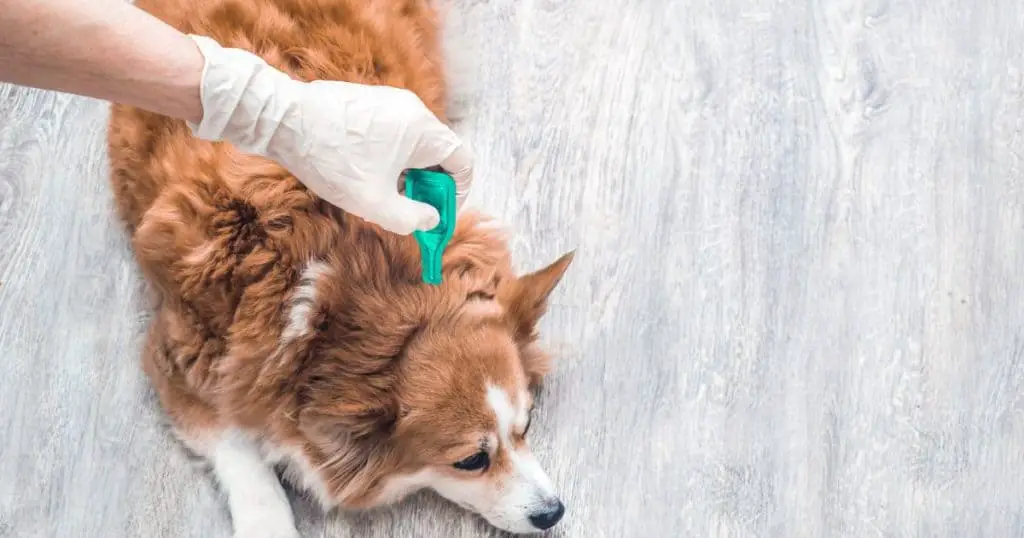
If your dog has developed skin problems after grooming, there are several treatment options available. The treatment plan will depend on the severity of the skin condition and the underlying cause.
In this section, we will discuss the most common treatment options for dog skin problems after grooming.
Topical Medications
Topical medications are applied directly to the skin to treat various skin conditions. They come in the form of creams, ointments, sprays, and shampoos. Topical medications are effective in treating skin infections, allergies, and other skin conditions.
Some of the common topical medications used for treating dog skin problems after grooming include:
- Antibiotics: Used to treat bacterial infections
- Antifungal medications: Used to treat fungal infections
- Corticosteroids: Used to reduce inflammation and itching
- Medicated shampoos: Used to treat skin infections and allergies
Oral Medications
Oral medications are given by mouth and are used to treat more severe skin conditions. They are prescribed by a veterinarian and are usually given for a specific period. Oral medications are effective in treating skin infections, allergies, and other skin conditions. Some of the common oral medications used for treating dog skin problems after grooming include:
- Antibiotics: Used to treat bacterial infections
- Antifungal medications: Used to treat fungal infections
- Antihistamines: Used to reduce itching and inflammation
- Steroids: Used to reduce inflammation and itching
Alternative Therapies
Alternative therapies can be used in conjunction with traditional treatments to help manage skin conditions. They are natural and can be used to reduce inflammation, and itching, and promote healing.
Some of the common alternative therapies used for treating dog skin problems after grooming include:
- Aloe vera: Used to soothe and heal the skin
- Coconut oil: Used to moisturize the skin and reduce inflammation
- Epsom salt: Used to reduce inflammation and itching
- Chamomile: Used to soothe the skin and reduce inflammation
In conclusion, there are several treatment options available for dog skin problems after grooming. The treatment plan will depend on the severity of the skin condition and the underlying cause. It is important to consult with a veterinarian before starting any treatment plan. They will be able to recommend the best course of action for your dog’s specific needs.
FAQs
Why does my dog have scabs after grooming?
Scabs on dogs after grooming can form on skin that has scratching irritation, whether from yeast, dry skin, or fleas. Additionally, shampoo might irritate scabby and flared-up skin even more. Groomers’ Land recommends keeping your dog’s ears, feet, and skin folds/wrinkles dry to prevent yeast infections.
Post grooming furunculosis symptoms
Post-grooming furunculosis is a bacterial infection that can occur after grooming. The most common symptoms of clipper burn in dogs include itching, redness of skin, and discomfort. Because clipper burns are cuts on the skin, there are always chances for a bacterial infection to set in. The chances are higher when the groomer shaves the dog’s hair all the way down to the bare skin. Dog Discoveries provides information on how to identify and treat post-grooming furunculosis.
My dog keeps sitting on his bum after grooming
If your dog keeps sitting on his bum after grooming, it could be due to anal gland problems. The anal glands are located on either side of the anus and can become impacted, leading to discomfort and pain. This can cause your dog to scoot on the ground or sit on his bum more often. PetMD provides more information on anal gland problems and how to treat them.
How long will my dog itch after grooming?
Itching after grooming is common in dogs, and it can last for up to a week. This is because the grooming process can strip the natural oils from your dog’s skin, leading to dryness and itchiness. PawSafe recommends using a moisturizing shampoo and conditioner to help soothe your dog’s skin after grooming.
Bumps on a dog after grooming
Bumps on a dog after grooming can be caused by clipper burn, which is a result of using clippers on sensitive skin. This can cause irritation, redness, and bumps. Additionally, if your dog has sensitive skin, the grooming process can cause hives or allergic reactions. Daily Dog Drama provides more information on common dog grooming injuries, including bumps.
How to treat post grooming furunculosis
Post-grooming furunculosis is a bacterial infection that can occur after grooming. The most common symptoms of clipper burn in dogs include itching, redness of skin, and discomfort. Because clipper burns are cuts on the skin, there are always chances for a bacterial infection to set in. The chances are higher when the groomer shaves the dog’s hair all the way down to the bare skin. Dog Discoveries provides information on how to identify and treat post-grooming furunculosis.

